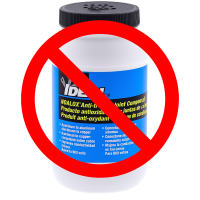jar546
CBO
For decades, electricians and inspectors have sworn by the ritual of slathering Noalox or similar compounds on aluminum conductors, convinced it was a critical safety step. But what if the very thing they've been doing all these years has been unnecessary? What if that gray goop is nothing more than a security blanket for habits rooted in fear and outdated information?
Let’s go back to where this all started. In the 1960s and 70s, aluminum wiring made its way into residential branch circuits due to a spike in copper prices. That wire was 1350 series aluminum—soft, prone to thermal creep, and highly reactive with oxygen. It formed a resistive oxide layer that didn’t conduct well, and it expanded and contracted more than copper. Combined with terminals not rated for aluminum and poor installation practices, the result was a disturbing rise in electrical fires. Noalox and other antioxidant pastes became popular during this time as a band-aid to reduce resistance and slow oxidation at the connection point. But make no mistake: the problem wasn’t just oxidation—it was bad wire and bad terminations.
The industry responded with a better product. In the early 1970s, manufacturers developed AA-8000 series aluminum alloy conductors. These conductors had improved mechanical strength, greater flexibility, and far less creep under thermal cycling. The NEC recognized the shift. Starting in the 1981 code, it required aluminum conductors in branch circuits to be AA-8000 alloy. That was over 40 years ago. This is not new technology. If you’re still acting like it’s 1978 and reaching for Noalox every time you see aluminum wire, it’s time to update your thinking.
Modern AA-8000 aluminum conductors are UL-tested under UL 486B with connectors specifically listed for aluminum without any antioxidant paste applied. That’s right—these connectors are not tested with Noalox. They are tested bare. If a connector manufacturer requires the use of an antioxidant, then yes, follow their instructions per NEC 110.3(B). But most of them don’t. If they did, the UL listing would require it, and the instructions would state it clearly.
So why do so many connectors still come with pre-installed paste? Simple—marketing and tradition. It keeps old-school electricians comfortable. It makes them feel like they’re doing something important. And some manufacturers add it as a failsafe because they know people will argue about it at the job site. But that doesn’t mean it’s required. In fact, blindly applying Noalox where it’s not needed can attract dirt and dust, and if applied incorrectly, it can do more harm than good.
It’s time to stop pretending that we’re dealing with the same wire we were in the 70s. If you’re using AA-8000 aluminum with connectors listed and tested for it, and you’re following proper torque specs and installation techniques, you don’t need Noalox. You need to let go of the myth. The paste isn’t protecting you—it’s protecting your ego.
The days of thinking every aluminum connection needs to be greased up are long gone. If you insist on applying it, ask yourself if you're doing it out of code requirement or just habit. Because if it's a habit, and you haven't looked at the actual listings and standards, then maybe you're not doing it right after all.

